Mohammed and his friends, a jolly and boisterous crowd of more than a dozen teenagers, are sitting on a picnic blanket, digging into a tray of kabsa the size of an entire lamb. Each of them are from across the Arabian Peninsula, from as far as Jeddah to the Northern Emirates, and they have been looking forward to this reunion for months.
It could only happen now, here, in this very spot. As he pauses to check on the tea, Mohammed looks up and his eyes get caught in the vista that surrounds him — seemingly endless kilometres of rolling hills, carpeted by gentle green grass and windswept trees.
The place I encounter this group, near Wadi Darbat, a valley in Oman’s south-western Dhofar region, isn’t usually like this. Every other time of year, it is much like the rest of Oman — a coarse landscape of jagged rocks. But this is the khareef, or monsoon season, which transforms this part of the country between July and September.
Khareef in Salalah
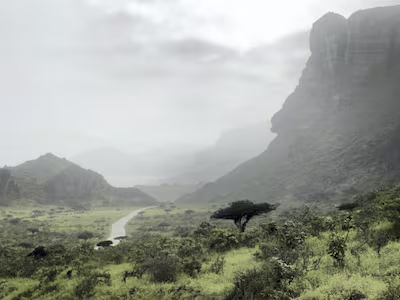
“A single gentle rain,” the American novelist Henry David Thoreau once wrote, “makes the grass many shades greener.” That is very much the hope in the region, where governments have invested millions of dollars into cloud-seeding technology in order to coax even the gentlest rains from an unyielding desert sky.
But this corner of Oman, a few hundred kilometres of coastline extending eastward from the Yemeni border, doesn’t need it. It’s a two-hour flight from Abu Dhabi, and during the khareef, monsoon clouds from the Indian Ocean blanket the region in a constant rolling mist. The gentle rain comes every day, and in the low mountains surrounding Dhofar’s main city, Salalah, shiny emerald-coloured grass sprouts up from the ground.
As the water accumulates on the landscape, it starts to flow. The wadis, usually dry riverbeds that famously scar the Omani landscape, become flush, and rivers carve their way through the mountains until they ease into babbling brooks or plummet into lower valleys in the form of waterfalls.
Ayn Khor waterfall
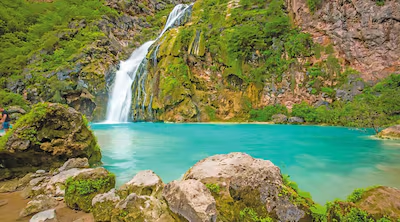
One such waterfall is Ayn Khor, about 25 kilometres north-west of Salalah’s airport. The water cascades over the slope of a mossy cliff face a few storeys high and lands in a rock pool so perfectly turquoise, you would think its contents were transported from an alpine lake. Going early in the day is a good idea — when there are no crowds, approaching Ayn Khor feels like coming across an old secret.
It isn’t easy to get there. The waterfall, along with many other gems of the khareef, is away from any paved road, and at the end of a semi-flooded riverbed. I make the journey in a 4x4 vehicle built for the task — a Nissan Patrol Super Safari. This high-end workhorse may be more commonly associated with dune-bashing in Liwa, but in Dhofar, it turns the river into a road, cutting through it like a knife through butter, even in places where the water level is a metre high. Crawling over small boulders and skating through the mud really feels more like playtime than a necessary chore. It only hits me what an adventure I've had when I reach the foot of the waterfall, step out and see the car is completely caked in mud.
A traditional tour of coastal Dhofar during the khareef season is grouped into two itineraries, West Salalah and East Salalah. Each deserves a separate day to traverse. Ayn Khor lies to the West, along with Mughsayl Beach and the region’s notorious “zigzag road”. To the East is Wadi Darbat and the waterfalls at Ayn Athum and Ayn Tobruk.
A luxurious base camp
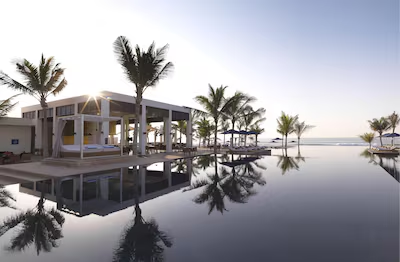
Bifurcated journeys such as these require a good base camp. During the khareef, Salalah becomes an oasis. But it needs its own oasis. And there are few better in the region than the Al Baleed Resort Salalah by Anantara, a sprawling yet intimate beachside complex.
I stay in a one-bedroom villa. Its layout is a masterpiece in compact luxury — a large bedroom flanked by a bathroom on one side and a kitchen and lounge on the other, all wrapped around a private pool. High walls ensure total privacy, and a gorgeous array of flowers, bushes and trees evoke the experience of bathing in one of Dhofar’s secluded rock pools.
Every morning, I wake to see the khareef’s mist hovering over the pool outside the bedroom’s floor-to-ceiling windows, as colourful birds balance on its stone edges to take a drink. The bathroom, paved with intricate stone, has a door leading straight into the pool. You can spend an entire weekend at the Anantara moving through this villa, from bath to pool to bed, with short breaks to enjoy a tray of traditional Omani deserts in the lounge.
One of the risks any hotel takes in investing so much in its sleeping quarters is that the common areas can never compete. In the Anantara, it’s clear they’re not meant to take up any more of your time than is strictly necessary. The hotel’s lobby, in the style of a sunken majlis, is only a restful place to take a beat and catch the eye of a staff member, who will promptly conjure a tray of dates and Omani coffee, or a cup of sweet, frankincense-infused water. You can also arrange with one of these staff members to prepare a full picnic that you can take on to the road with you when you venture out into the mountains.
Outside an infinity pool looks out over the beach. At other times of the year, it would be a retro-minimalist beach holiday setting, and the infinity pool would be the obvious centrepiece. But in these months, even here, the khareef demands all your attention. The seawater is turbulent with rage; waves that can sometimes reach double your height swell up and crash down on to the beach with such a fury that the hotel staff constantly implore everyone now to venture more than a few metres on to the sand.
The West Salalah tour
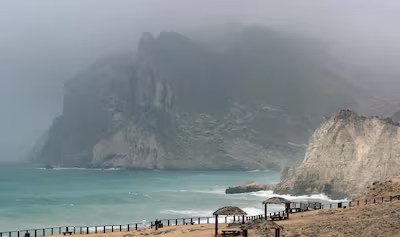
The khareef is not all rolling mists and gentle rains. The West Salalah tour, better suited to the more intrepid traveller, reveals its savage side. The roads that take you from Salalah towards Al Mughsayl Beach are winding, hilly and occasionally reduced to a single functional lane. Your windscreen wipers will get good exercise; intermittently throughout the day, the mist will become fog, and it fights you every step of the way. A few days before I visit Al Mughsayl Beach, a long stretch of sand abutted by towering cliffs, its currents had swept an Indian family on holiday into the water, killing three of its members.
About 15km past the beach, in the direction of Yemen, the road heads into the Dhofar Mountains. For those who have driven in the northern parts of Oman, this part of the journey will seem familiar: it’s all hairpin turns and steep ascents. There is no specific destination here. The road this time of year is a test of mental stamina, though you are rewarded by extraordinary viewpoints along the way, where you can watch the drama of the monsoon-ridden coast as if you are sitting in the sky.
I failed the test a little over an hour in, when, after one particularly mind-bending ascent in low gear, I reached a narrowing of the road between two mountain peaks, the gap between them taken over completely by the khareef’s fog. Even the Super Safari’s piercing fog lights could not allow me to see more than two metres ahead. I had to manoeuvre myself into a three-point turn to turn around and head back the way I came, honking the horn at two-second intervals to alert any surprise traffic.
Exploring East Salalah
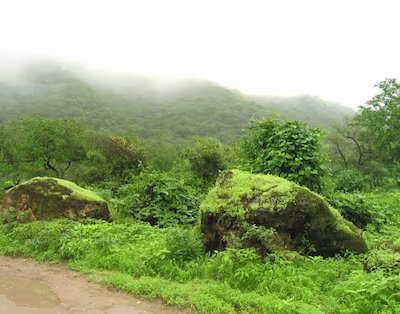
The East Salalah leg is more forgiving. It starts with a journey through some of Salalah’s charming walled streets. The city can, at first, seem underwhelming. Although Salalah holds a special place in Omani lore as the country’s one-time seat of power — the sultanate had its seat there from the 1930s until 1970 — today its royal trappings are obscured by its evolution into a dusty, largely industrial port city. But some of its environs are seeing a renewal, and the low walls that line a few of the newly paved roads revive some of its old prestige.
Driving through these parts of the city, you pass by palatial government complexes and fertile date and banana plantations. These local banana varieties are worth trying; they’re smaller and more bitter than their supermarket cousins, but along with the fresh kebab grilled in tents on the side of the motorway, they’re the perfect road-trip snack.
Waterfalls and wadis
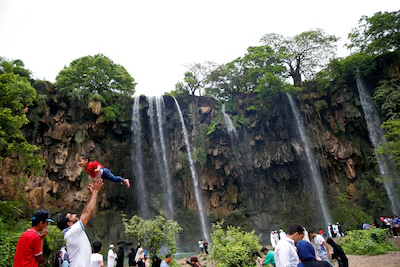
After getting on to the motorway — where I frequently had to slow down to ease my way around a series of camel trains — and reaching the town of Taqah, a fishing village built around an old castle, I headed north into the hills towards Wadi Darbat, with diversions into Ayn Athum and Ayn Tobruk. These two waterfalls have all the immediate splendour of their western cousin Ayn Khor, but are more established tourist sites, with makeshift parking areas and food stalls.
There are, however, ways to get out of the crowd and discover something new. At Ayn Athum, I was attracted by strange sounds off to one side of the path, and climbed over a small rock wall and through a small cave to discover a serene, clear pool with a small waterfall that was a paradise for hundreds of local frogs.
For centuries, people have come from around the Gulf and beyond to see what the khareef makes of Wadi Darbat. In the pre-modern era, they did so using celestial navigation and the directions of kind strangers. Unfortunately, the latter remains the best option. Following Google Maps to Wadi Darbat takes you along a very scenic path of pastoral green country roads to the top of a low, flat mountain until you reach someone’s isolated private home, where you will see other cars parked in their driveway, surrounded by herds of cattle, frustrated at having made the same error. It can be a happy mistake, however, as the hills surrounding Wadi Darbat offer much more in the way of vistas than the wadi itself.
This is where I encountered Mohammed and his friends. I was reluctant to fall into the trap of describing it by way of comparison to other parts of the world, so I decided to trick someone else into making it for me. As I finished my own fistful of kabsa, courtesy of Mohammed’s hospitality, I walked back to the car and stopped to take a photo of the grass and the trees and the cattle blanketing the valley, and I sent it to a friend of mine from Ireland. “I’m in your home country,” I wrote. “Green hills and wet skies,” he wrote back. “Yep, that’s Ireland.”
“I’m sorry to break it to you,” I replied, “but I lied. I’m still in the Gulf, and this is Oman.”









